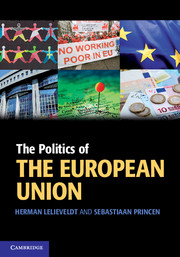Book contents
- Frontmatter
- Contents
- Acknowledgements
- List of briefings
- List of fact files
- List of controversies
- List of tables
- List of figures
- List of abbreviations and acronyms
- List of country abbreviations used in tables and figures
- Preface
- PART I Setting the scene: origins, analytical perspectives and institutions
- PART II Key actors in EU politics: citizens, interest groups and political parties
- Part III EU policies: agenda-setting, decision-making and implementation
- 8 An overview of EU policy-making
- 9 Agenda-setting
- 10 Decision-making
- 11 Implementing policies
- Conclusions and reflections
- Key terms and concepts
- Index
8 - An overview of EU policy-making
from Part III - EU policies: agenda-setting, decision-making and implementation
- Frontmatter
- Contents
- Acknowledgements
- List of briefings
- List of fact files
- List of controversies
- List of tables
- List of figures
- List of abbreviations and acronyms
- List of country abbreviations used in tables and figures
- Preface
- PART I Setting the scene: origins, analytical perspectives and institutions
- PART II Key actors in EU politics: citizens, interest groups and political parties
- Part III EU policies: agenda-setting, decision-making and implementation
- 8 An overview of EU policy-making
- 9 Agenda-setting
- 10 Decision-making
- 11 Implementing policies
- Conclusions and reflections
- Key terms and concepts
- Index
Summary
Introduction
Smoking may not be the first thing you come up with when thinking about the issues the European Union deals with. Yet, over the past two decades, the EU has built up a considerable amount of legislation relating to smoking and tobacco products. When you buy a pack of cigarettes (for educational purposes only, of course!), you can see EU policies at work. For instance, the EU has adopted Directives on the maximum levels of tar and nicotine in cigarettes. The price you pay for the pack of cigarettes largely consists of excise duties that governments levy; an EU Directive lays down the minimum amounts of these excise duties. You will probably also notice the large texts on the pack, warning you of the health risks of smoking. Not only have EU Directives made these warning texts mandatory throughout the EU, but they also specify how large they should be and what texts can be used. Finally, tobacco advertising has been banned both on television and in newspapers and magazines.
At the same time, the EU's role in this field is largely confined to adopting legislation and setting standards. The actual implementation of the policies is left to member state governments. Likewise, although the EU is very active in the field of regulatory policy (promulgating norms and standards), it is much less involved in distributive policies (financing facilities) and redistributive policies (affecting the distribution of income and wealth).
- Type
- Chapter
- Information
- The Politics of the European Union , pp. 179 - 204Publisher: Cambridge University PressPrint publication year: 2011
- 1
- Cited by

